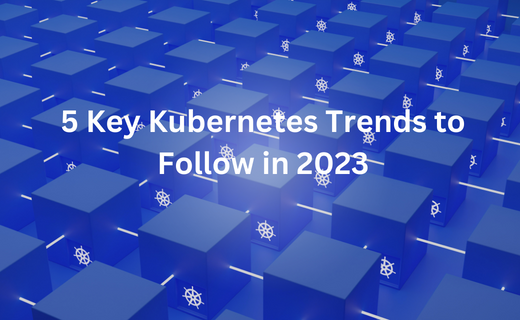-

5 Key Kubernetes Trends to Follow in 2023
Since its inception in 2014, Kubernetes has been one of the fastest-changing technology platforms. Kubernetes is likely to be a key area of innovation in 2023 as the platform continues to evolve with the addition of new tools and techniques. It will be interesting to see how things play out and if any interesting trends emerge over the year.
What is Kubernetes
Kubernetes, also known as K8s, is an open-source system for automating the deployment, scaling, and managing containerized applications. It groups containers that make up an application into logical units for easy management and discovery. Kubernetes builds upon 15 years of experience running production workloads at Google, combined with best-of-breed ideas and practices from the community. Here are five trends to watch out for in 2023:
Cost Optimization
Like the cloud or virtualization, Kubernetes has the potential to save lots of money by operating workloads more efficiently. But the key word there is "potential." If Kubernetes is poorly configured, it can cost more money than it saves due to unnecessary or over-provisioned nodes.
Cost optimization is an increasingly important trend in the Kubernetes ecosystem. Many vendors — like Fairwinds and CloudZero — are investing in tools designed to help businesses measure and optimize their Kubernetes spending. Such solutions are existing cost management tools extended to support Kubernetes, while others were built from the ground up specifically for Kubernetes cost management.
Going forward, expect more businesses to add cost management tools to their Kubernetes tool set as they look for ways to maximize the return on their investment in Kubernetes-based deployment.
Kubernetes Edge Computing
Kubernetes was initially designed to host applications on conventional servers inside traditional data centers. But there is a growing interest in using Kubernetes as an edge computing solution. Kubernetes manages clusters of devices that don't exist inside conventional data centers. Instead, the devices are things like smart home sensors or internet-connected vehicles.
Some major technical challenges to overcome to use Kubernetes at the edge include ensuring low-latency networking between the Kubernetes control plane and edge nodes that might be thousands of miles away. But these difficulties can be surmounted, which is why there is a decent chance that we'll see more Kubernetes deployments at the edge, not just in cloud data centers.
Multi-cluster Kubernetes
Using a single Kubernetes control plane to manage more than one cluster of nodes — a practice known as multi-cluster Kubernetes — has existed in one form or another since the introduction of the Kubernetes federation several years ago.
But it has been only within the past two years that tools for managing multi-cluster Kubernetes have evolved to the point that multi-cluster deployments are now realistic. The tools can now clear the steep technical hurdles with multi-cluster management, such as managing network connections between clusters to facilitate secure inter-cluster communication.
Multi-cluster Kubernetes is critical because it makes it feasible to distribute workloads using namespaces and entirely distinct clusters. Doing so provides more security and performance protections than you can get using namespaces, which offer only virtualized segmentation between workloads.
As a result, multi-cluster Kubernetes makes Kubernetes more valuable for use cases that involve very stringent security requirements or where it's critical to avoid the "noisy neighbor" problems that can happen when multiple workloads share the same hosting infrastructure.
Usability
It is no secret that using Kubernetes is considered “hard” or “damn complicated,” as noted by numerous warnings on the internet. But you could have said the same about Linux in the 1990s or the Amazon cloud in the mid-2000s.
Like other major technologies that preceded it, Kubernetes is still growing, and there remains plenty of room to improve by improving its usability.
Currently, most of that work is being done by commercial software vendors, which are building tools — many of them proprietary — to help streamline or automate Kubernetes setup and management. But there's also at least some effort at the community level to improve Kubernetes usability, such as the Usability Special Interest Group (which, sadly, now appears to be closing, but at least it set a precedent for Kubernetes usability improvements without a commercial spin).
Kubernetes Adoption
Finally, partly because Kubernetes is not as easy to use as some folks might wish, pushback against Kubernetes has become a significant trend. Numerous entities question the need for the platform, saying it’s not a great solution.
This pushback doesn't mean that Kubernetes will die off. But it does mean businesses are increasingly likely to have reservations about Kubernetes. We'll perhaps even start to see some "Kubernetes repatriation" trends in which companies migrate workloads from Kubernetes to a different solution, as has happened with some cloud workloads.
In conclusion, Kubernetes may be mature enough to host production workloads, but major change is afoot regarding when and how organizations use Kubernetes. We believe the above trends will reshape the way Kubernetes is used in the real world over the coming year and beyond.
Follow Us on LinkedInAbout the Author

Kamal Rastogi is a serial IT entrepreneur with 25 yrs plus experience. Currently his focus area is Data Science business, ERP Consulting, IT Staffing and Experttal.com (Fastest growing US based platform to hire verified / Risk Compliant Expert IT resources from talent rich countries like India, Romania, Philippines etc...directly). His firms service clients like KPMG, Deloitte, EnY, Samsung, Wipro, NCR Corporation etc in India and USA.